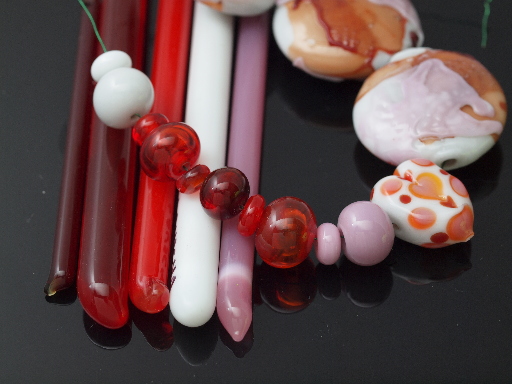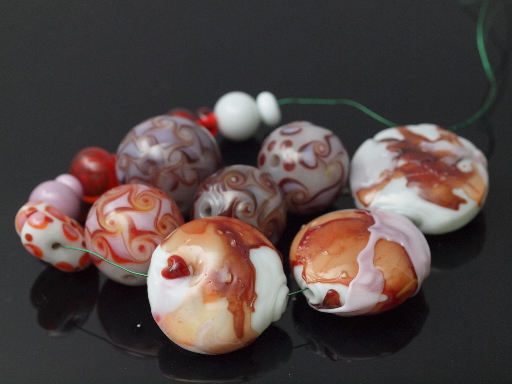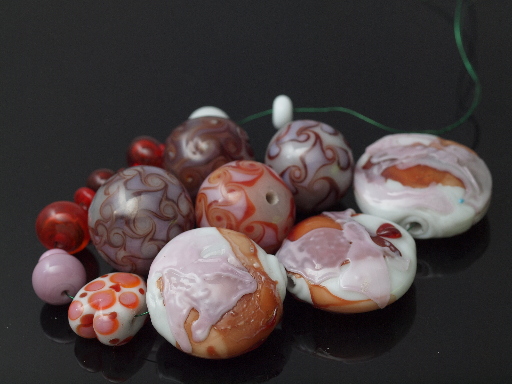This year, our guild is using lauscha for our monthly challenges. Often they have a holiday theme; so for February[1] we got white, pink and red glasses:
- middle dark red, LA0220MP (v. similar to check garnet, dk trans red)
- transparent red, LA219
- opaque/translucent red 009
- vanilla ice (odd) 382
- fuschia 420 (dark translucent bluish pink)

Shows samples of the rods, sample beads and the heart bead. Click on the image to see cracking (mostly located around the dots) on the heart, indicative of the white not being very compatible with the rest.
I've been playing with lauscha on and off for years—I have a sample strand somewhere made with a lot I purchased from GlassDaddy[2] The purple was reputed to be gorgeous—similar to EDP, but without the evil devit— and compatible with effetre. Lauscha, like the Reichenbach we used last year, is primarily a furnace glass, with the expectation that the glassworker will test for compatibility.
Which is what I did, albeit accidentally:[3]

hollow tessalated beads, 3 of which are actually on check glass milky white that tested very similarly to the lauscha odd lot white, range in size from 21–24mm (e620 photoed 29feb16)
If you click on the image to get the full-size version and examine the lentils carefully, you will see crazing running throughout the bead; and the reason I know it's incompatibility is that those cracks didn't show up immediately. This was a little disappointing for me: I didn't expect the lauscha to necessarily be compatible with effetre (it's designed to work with 83 or 87 batch and the like...) I did presume it would behave itself.
To be fair not all the beads are made on the lauscha white. Some of them are made on czech white that thread-tested almost identically to the lauscha white. The deflection of the threads[4] should've been a clue, I guess.
The lauscha shards cracked on both the lauscha and czech white base beads. For some reason, tessallation seems more resistant to incompatibility stress than other techniques, such as dots or shards:

reverse of the lentils. There was one very dark transparent red (that looked brown in the rod, it was so dense); a translucent-to-opaque red, a bright red transparent, a dark purplish-pink and an odd-lot opaque white with a greyish cast, which gives it an appealing ‘old-timey’ feel I quite like. The shaped heart & front-and-center lentil are definitely made on the lauscha white.
I'm not really sure why this is—the overall pattern obviously helps distribute the stress, and mebbe the tails do as well—but I made this discovery years ago, playing with pi glass.[5]
It's too bad, because the colours are luscious—the reds especially. Well, one of the nice things about bead embroidery is that I can convert this glass into a bunch of pretty spacers for that, at least.
[1]I.e. glass handed out at the January meeting
[2]IIRC, so far back in the dark ages he required his customers to pay with check.
[3]Cuzza making the assumption that rods for lampworkers would be compatible. Silly me!
[4]which I didn't record or measure, sorry, as I was just trying to get a match.
[5]I have a picture of the one surviving bead but evidently wasn't as interested in documenting my failures—there are so many, after all.
Unless otherwise noted, text, image and objects depicted therein copyright 1996--present sylvus tarn.
Sylvus Tarn